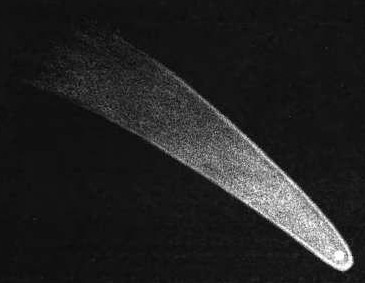
Great Comet of 1811 as drawn by William Henry Smyth
The May issue of Sky and Telescope magazine has a timely item about “Napoleon’s Comets”. The most important of these was the Great Comet of 1811, which was the brightest comet with the longest duration of brightness on record (260 days) until Comet Hale-Bopp shattered that record in 1997.
It is referred to as “Napoleon’s Comet” because of the Napoleonic Wars and the impending War of 1812, in which the United States was allied with France, Germany and Austria against Britain, Spain, Portugal, and Russia. The wars are the backdrop for the novel War and Peace by Tolstoy, and also the newly Tony-award-nominated Broadway musical Natasha, Pierre and the Great Comet of 1812 based on a small part of the novel.
The Comet of 1811 was discovered in March of that year in what is now the constellation Puppis, and it was very bright in the evening sky in September and lingered for the rest of that year. The head and coma of the comet was reported to be wider than the diameter of the Sun and it had a very long, bright tail despite not coming very close to the Earth. The Comet was held to be responsible for unusually fine vintages of French wines harvested from the Autumn 1811 grape harvest, and it is possible that Napoleon was influenced in his decision to invade Russia in June 1812 if he thought of the comet as a portent of victory.
In the US midwest, the Comet was visible during the New Madrid Earthquakes in December 1811. The Shawnee leader Tecumseh, who was born in the year of the Comet of 1769 and was named accordingly, invoked the Comet of 1811 as he built a confederacy of tribes which allied with the British in the War of 1812.
The Comet of 1811 is only mentioned on one page at the conclusion of the first half of War and Peace, but it’s misnamed the Comet of 1812. Accordingly, although the musical is titled Natasha, Pierre & the Great Comet of 1812, the Comet only appears in the finalé and is not depicted in the publicity for the production. You have to go and see it for yourself. Dave Malloy, the creator of the show, says the Comet nevertheless got into the title of the show “for cosmic epicness”.
The Broadway production this year has been nominated for 12 Tony awards, so I can’t imagine it not being talked about in planetariums.
SciDome Implementation
You can add the orbit of the Great Comet of 1811 to your SciDome by right-clicking on the Sun in Starry Night Dome Preflight and selecting “New Comet…” In the orbit specification window that pops up, enter the following values:
Name: Great Comet of 1811 Eccentricity: 0.9951250 Pericentre distance: 1.0354120 Ascending node: 143.0497000 Arg of pericentre: 65.4097000 Inclination: 106.9342000 Pericentre time: 2382768.2562000 Elements epoch: 2382760.5
And in the “Other Settings” tab, change the Diameter to 40 km and change the Absolute magnitude to 0.
“X” out of the new orbit window and confirm you want the changes to be saved. Then quit out of Starry Night properly.
If you are using Starry Night Dome version 6, the comet will be loaded on to the Renderbox when Starry Night is properly exited and will be available the next time the application is started. Because it is a user-created object, though, it will be automatically “hidden” until you uncheck it in the “Hide” column of the Find Pane. Then you can save some favourites showing the sky in the year 1811 featuring it for later playback.
If you are using Starry Night Dome 7, the comet will be saved into a file named User Planets.ssd in the Preflight folder:
C:\Users\Spitz\AppData\Local\Simulation Curriculum\Starry Night Prefs\Preflight
And that file will need to be manually ported over to the corresponding location on the Renderbox. Future versions of Starry Night Dome V7 will make this process automatic.
